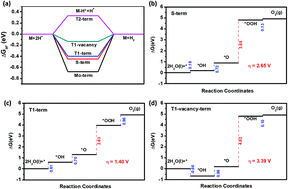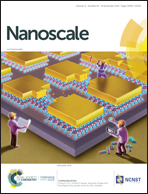Design of high-performance MoS2 edge supported single-metal atom bifunctional catalysts for overall water splitting via a simple equation†
Abstract
MoS2 edges exhibit good hydrogen evolution reaction (HER) activity but poor oxygen evolution reaction (OER) activity. The development of MoS2 edge supported single-atom catalysts (SACs) for both the HER and OER is critical for overall water splitting. In this work, for the purpose of triggering OER performance and maintaining HER performance, 28 single transition-metal (TM) SACs supported on MoS2 edges as bifunctional electrocatalysts for overall water splitting have been screened by using density functional theory (DFT) calculations. In order to design and achieve high OER performance, a simple equation derived from the chemical environment and local structure of the active center is used as a structure descriptor to predict the OER activities of MoS2-based SACs. Among these candidates, the T1-vacancy termination modified using a Pt single atom shows the lowest theoretical overpotential for the hydrogen/oxygen evolution reaction being just −0.10/0.46 V, respectively, which is comparable to those of the precious-metal-group benchmark catalysts for overall water splitting. It is expected that our results can offer a theoretical basis for simplifying and steering the design of efficient electrocatalytic materials.

- This article is part of the themed collections: Editor’s Choice: Computational studies of nanomaterials for energy, catalysis and electronics and Editor’s Choice: Single-atom and nanocluster catalysis


 Please wait while we load your content...
Please wait while we load your content...